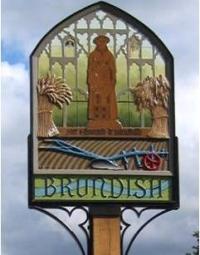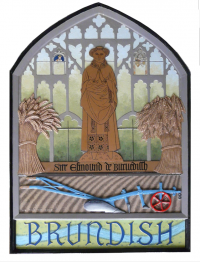

Brundish
a small village in rural High Suffolk


a small village in rural High Suffolk
 Brundish is situated at the head of the shallow Alde Valley in an area known as the High Suffolk Plain. The River Alde has its source within the parish boundary. There are seventy or so houses scattered over mainly arable farmland with a population of approximately 160 people, including children.
Brundish is situated at the head of the shallow Alde Valley in an area known as the High Suffolk Plain. The River Alde has its source within the parish boundary. There are seventy or so houses scattered over mainly arable farmland with a population of approximately 160 people, including children.
The design of the Brundish sign is based on the historical roots of the village. It symbolises its bonds with the land and the parish church of St. Lawrence.
The sign is placed within the village green at a cross of four roads, known as Crown Corner. As one approaches Brundish from any direction the sign creates a pleasing impression with the village green in the background.
Our village sign typeface used for the name 'Brundish' was designed exclusively for the sign. The background of the name panel represents the origin of the word Brundish. The Oxford Dictionary of English Place Names shows that ‘Brundish’ comes from the Old English ‘burna’ and ‘edisc’ meaning ‘a stream with pasture’. The stream almost certainly refers to the River Alde. The name panel thus illustrates the meander of a stream surrounded by green pasture.
The overall shape of the sign was brought about by observing the magnificent perpendicular east window in Brundish Church with its delicate tracery. This tracery was painstakingly re-created in the top segment of the sign. The main figure is a priest in eucharistic vestments. This is Sir Edmund de Brundish, as depicted on one of the brasses in Brundish Church and dating from about 1380. On either side, and with great attention to detail, the maker has incorporated two characters featured in the original. On the left hand side of the window is the crowned head of a king. On the right is a rather bizarre caricature of a demon, not surprisingly a rare occurrence in ecclesiastical stained glass. The depiction of sheaves and a plough and ploughed field below signify our close ties with the land.